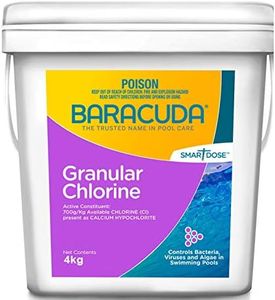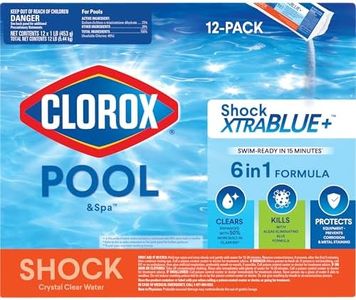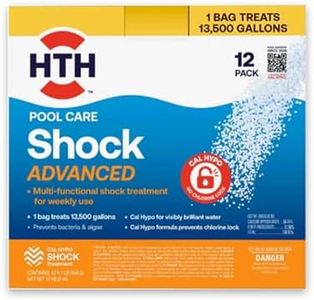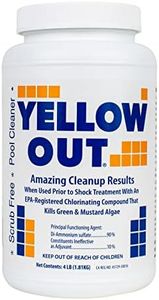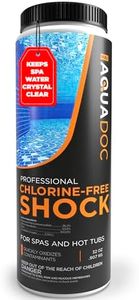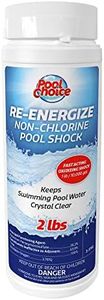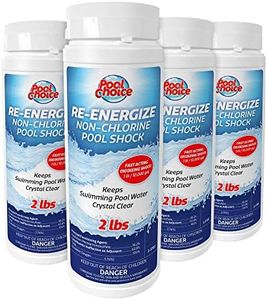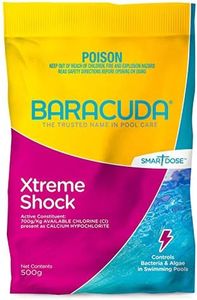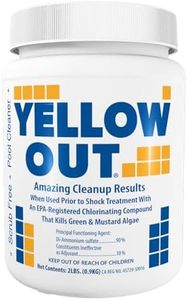We Use CookiesWe use cookies to enhance the security, performance,
functionality and for analytical and promotional activities. By continuing to browse this site you
are agreeing to our privacy policy
10 Best Pool Shocks
From leading brands and best sellers available on the web.Buying Guide for the Best Pool Shocks
Choosing the right pool shock is crucial for keeping your swimming pool clean, clear, and safe for swimming. Pool shock refers to a chemical treatment used to quickly raise the level of free chlorine in your pool to eliminate bacteria, algae, and other contaminants. The process of shocking is important for routine maintenance, after heavy use, or following rainstorms. To pick the ideal pool shock for your needs, it's important to understand the main types, concentration, and other features that affect both how well it works and how convenient it is for you.Shock TypePool shocks come in different chemical formulas, with the most common being calcium hypochlorite (cal-hypo), sodium dichlor, lithium hypochlorite, and non-chlorine (potassium monopersulfate). This specification determines how the shock works and what side effects it may have on water chemistry. Cal-hypo is strong and inexpensive but can add hardness to your water, which might not suit all pools. Dichlor is gentler on pool surfaces and adds both chlorine and stabilizer, making it great for certain types of pools. Non-chlorine shocks are ideal for those wanting to swim soon after treatment and avoid chlorine smell, but they don’t kill algae as effectively. Your pool type, water chemistry, and sensitivity to chlorine should guide your choice.
Chlorine ConcentrationThis specification tells you how much available chlorine the shock provides, often measured as a percentage. Higher concentrations shock the pool faster and more effectively kill bacteria and algae. Typical values range from 40–78% for cal-hypo shocks, while non-chlorine shocks contain no chlorine at all. Pools facing frequent contaminants or algae outbreaks may benefit from higher concentrations, while routine maintenance may require just moderate levels. Think about how heavily your pool is used and what kind of issues you face.
Dissolving SpeedDissolving speed indicates how quickly the shock dissolves once added to water, affecting convenience and pool safety. Fast-dissolving shocks (like many dichlor and non-chlorine options) won’t leave residue and can be added directly to the pool, making them easy for quick treatments. Slower-dissolving shocks might need pre-dissolving and can cause cloudiness or surface damage if used improperly. If you prefer a fuss-free experience or have delicate pool surfaces, go for rapid-dissolving types.
Effect on Water ChemistrySome shocks can increase certain pool parameters, such as calcium, stabilizer (cyanuric acid), or pH. For example, cal-hypo raises calcium levels, which could be a concern in areas with hard water, while dichlor increases cyanuric acid, helping to protect chlorine from sunlight but potentially raising levels too high over time. Non-chlorine shocks have little impact on these parameters. Knowing your current water chemistry and local water conditions will help you decide if you need a shock that minimizes these changes.
Wait Time Before SwimmingAfter shocking, you need to wait until chlorine levels return to safe limits before swimming, which is influenced by the shock used. Chlorine-based shocks typically require a wait time of 8–24 hours, while non-chlorine shocks allow swimming much sooner, often within an hour. If you want the pool ready quickly after treatment, or you have kids who can’t wait, pick a shock with a short re-entry interval.
